Yellow cucumbers are a common problem that many gardeners face, but what causes the color change? In this post, I’ll discuss all of the possible causes, and give you tons of tips to prevent it from happening.

Healthy vines are in bloom and you’re excited to start enjoying the fruits of your labor, only to notice you have yellow cucumbers.
It can be very frustrating and confusing, but even experienced gardeners battle with this problem. Thankfully, there are often simple ways to prevent it from happening.
Below I’ll help you troubleshoot the potential causes behind the discoloration, and share what you can do to prevent yellow cucumbers in the future.
Why Are My Cucumbers Turning Yellow?
It can be difficult to tell exactly why your cucumbers are turning yellow, and you may never know for sure why it happened. But in this list you’ll find some of the most common causes so you can narrow it down.
1. Yellow Cucumber Varieties
Before you panic, double check the seed packet or plant tag. Your yellow cucumbers might be natural! There are several varieties that actually come in this color.
- Lemon cucumbers – These small round fruits have a yellow spiky rind and light green-ish flesh.
- Apple cucumbers – This variety is also small and round, but features white flesh under the yellow skin.
- Chinese yellow cucumbers – Oval fruits start green then mature to a lemony hue with some orange hints.
- Dosakaya – This Indian cultivar is either round or oblong with a thin yellow rind.

2. Poor Or Lack Of Pollination
If the female flowers are never pollinated, the tiny baby cucumbers will turn yellow and drop off the vine before long.
But poor pollination could be the culprit on mature fruits. Each female flower needs to be pollinated several times.
When it receives too little, the resulting cucumber is usually malformed and yellow or orange in color.
Related Post: 13 DIY Cucumber Trellis Ideas For Small Or Large Spaces
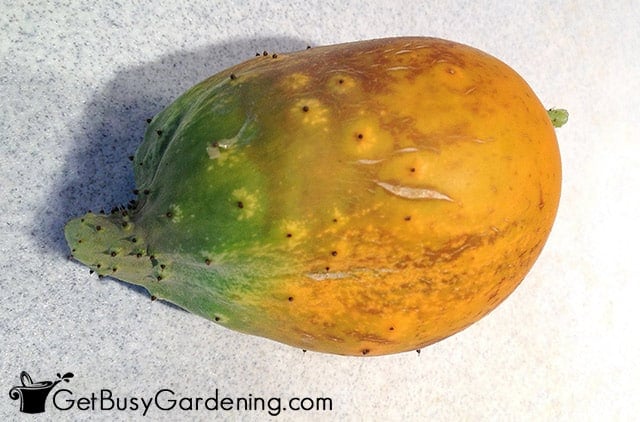
3. Overripened
One of the most common reasons for the color change is simply leaving them on the vine too long. Over-ripened cucumbers will turn yellow and become bitter.
If yours are also puffy, large, or have sunken areas or wrinkles, this is likely the problem.
It may be tempting to wait for larger fruit, but the flavor and texture is actually better in small ones. So bigger is not better in this case. To prevent this, learn exactly when & how to harvest them here.
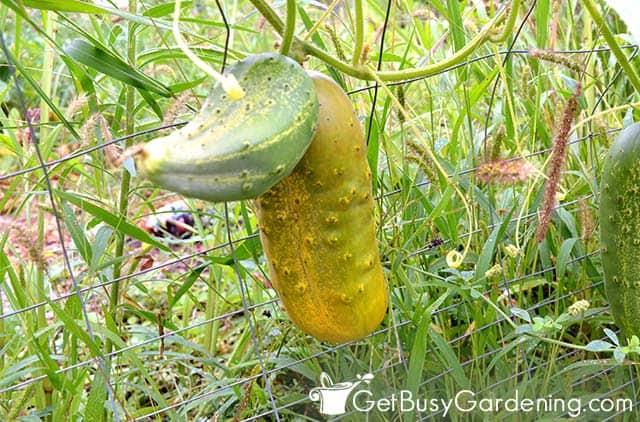
4. Improper Watering
Another potential reason could be too much water. Cucumbers have shallow roots and want even moisture.
But leaving them with wet feet makes it hard for them to absorb what they need from the soil.
Water deeply in the morning a few times a week if your region doesn’t get rain. Let the top inch dry out between drinks, but no more than that. Use a moisture gauge if you struggle with this.
5. Nutrient Deficiencies
Lack of nutrients is another possible explanation. Nutrient deficiencies can cause issues during fruit formation and ripening, and yellow cucumbers are often the result.
This is especially true if you plant your vines in the same area every year, because the soil can become depleted over time.
Apply an organic liquid fertilizer every other week, or top-dress them with slow-release granules monthly to give them what they need.
Related Post: How & When To Fertilize Your Vegetable Garden
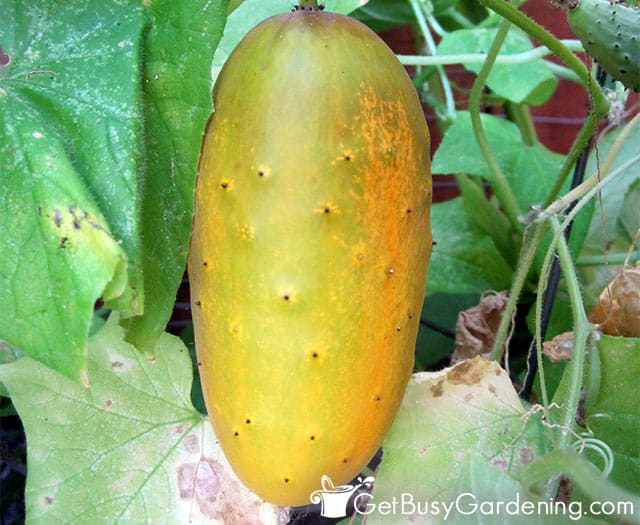
6. Virus Or Disease
There are a variety of diseases that can attack your plants and affect the fruit, but the most common is the mosaic virus.
You may see misshapen leaves mottled with tan or brown as a precursor to bitter, yellow cucumbers. Treat with fungicide early on, but if it continues, destroy the plant before it spreads through your garden.
Powdery mildew may also be the culprit. The thick white powder can hinder photosynthesis. Prune away those leaves, and try to keep them dry when you water. Neem oil can help to kill the mildew if treated early enough.
Can You Eat Yellow Cucumbers?
Whether or not you want to eat yellow cucumbers really depends on the cause. The varieties that have this natural hue are delicious.
But if the color change is due to improper care, it usually leads to tough skins and a bitter flavor, which doesn’t taste great.
I’d recommend getting rid of any that are diseased, but overripe or misshapen ones can technically be eaten. The question will be if you want to, depending on how bitter, tough, and seedy they are.
Related Post: How To Grow Cucumbers On A Trellis
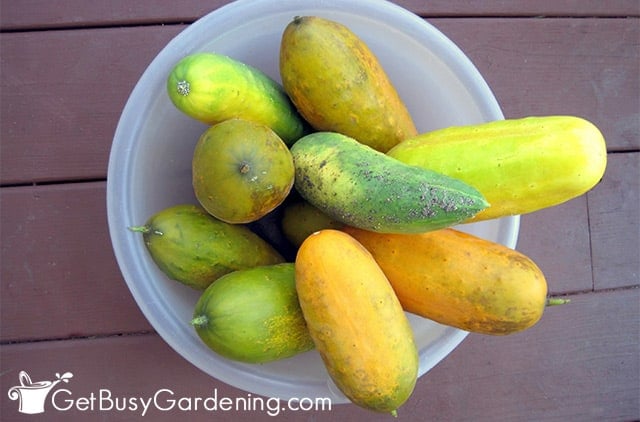
How To Prevent Yellow Cucumbers
The best way to prevent yellow cucumbers is by learning how to give them the proper care. There are several steps you can take to avoid this common problem.
- Keep them evenly moist, but never soggy or completely dried out.
- Attract more bees to your veggie garden to help with pollination.
- Pick them at the right time, usually when they’re between 2-8”, firm and deep green.
- Use an organic, balanced fertilizer, or one slightly higher in phosphorus.
- Rotate your crops each year to prevent disease and nutrient deficiencies.
- Hand pollinate female flowers to ensure more healthy fruit formation.
Learn all about how to properly care for cucumber plants here.
What To Do With Yellow Cucumbers
It’s frustrating to lose all of your hard work, so you may wish to try and salvage what you can. While I don’t suggest eating diseased or damaged fruits, you may be able to save some yellow cucumbers.
Salsa or relishes are a good way to use slightly overripe ones. Acidity eliminates the bitterness that would make them unpleasant. Don’t try to use them for making pickles though, or they will only turn to mush.
Overripe cucumbers often bear viable seeds too, which you can collect and save for next year’s planting (learn how to start the seeds here).
Of course, unusable ones can always serve your garden by making great fodder for your compost bin.
While yellow cucumbers are frustrating, learning the causes can help you recover this year’s crop, and learn for next year. With these tips you’ll be able to troubleshoot the possible problems, and get your plants back in good health.
If you’re ready to take your veggie garden to new heights, then you need a copy of my Vertical Vegetables book. It has all you need to be successful with growing vegetables vertically, plus tons of beautiful DIY projects you can build in your garden. Order your copy today!
Learn more about my Vertical Vegetables book here.
More About Vegetable Gardening
- Tomatoes Not Turning Red? Try These 5 Tricks…
- How To Pollinate Squash By Hand For Maximum Production
Share your tips for how to prevent yellow cucumbers in the comments section below.
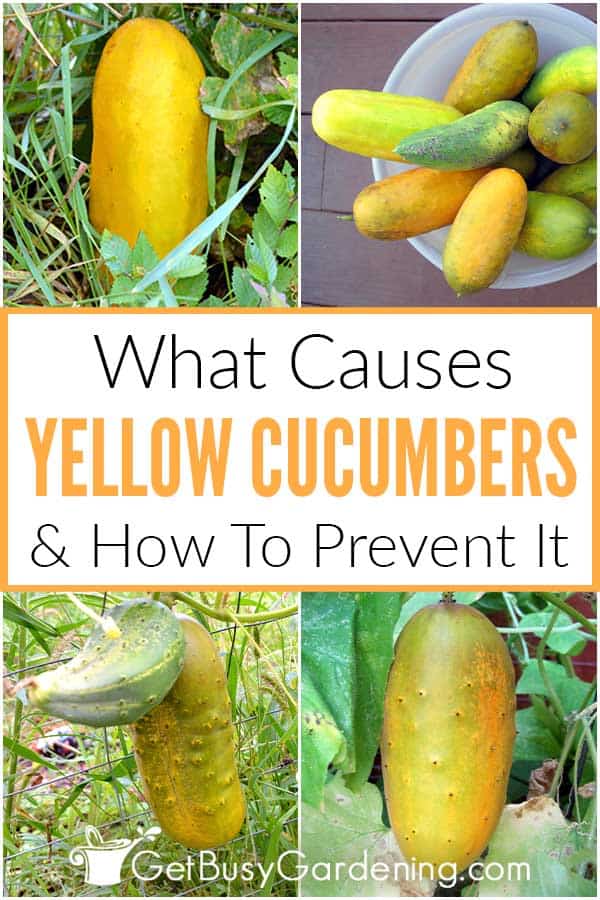
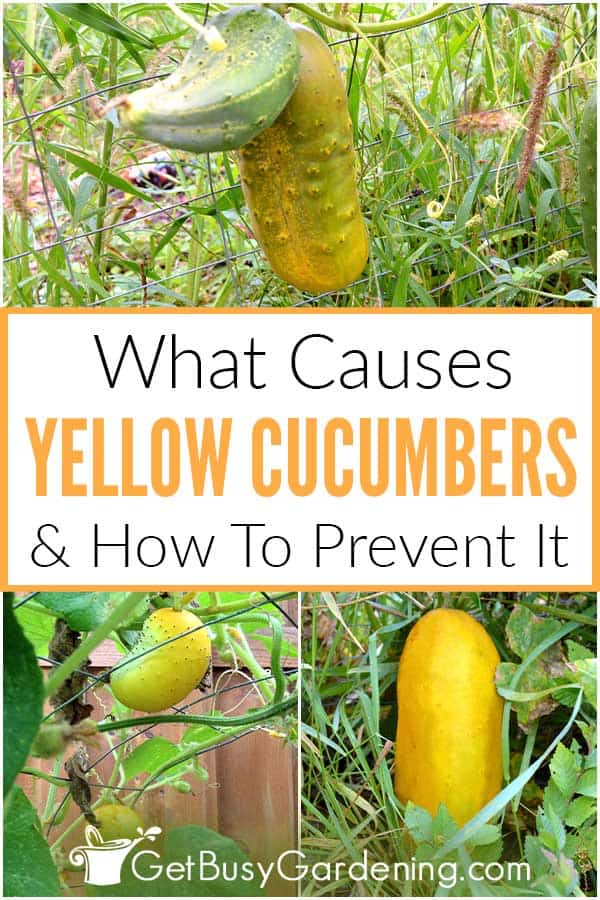




Dave says
what if it’s an all female variety?
Amy Andrychowicz says
There’s no such thing as an all female cucumber plant. All varieties produce both male and female flowers.
Donna Hanson says
Grew one plant in a pot. Cucumbers get about 2″ long, then turn yellow and shrivel up. Finally one grew 6″ long and it too turned yellow and dried up. This variety is supposed to love the heat and it has been in the 90’s all summer. The plant is 6′ tall and has had 20-30 cukes develop but all have turned yellow and dried up. It receives sufficient water and fertilizer. I am in Zone 11-A. Any help would be appreciated.
Amy Andrychowicz says
When small cucumbers turn yellow and shrivel up, that means they didn’t get pollinated. You can help them out by pollinating them by hand, or plant flowers nearby to attract bees to do the job for you.